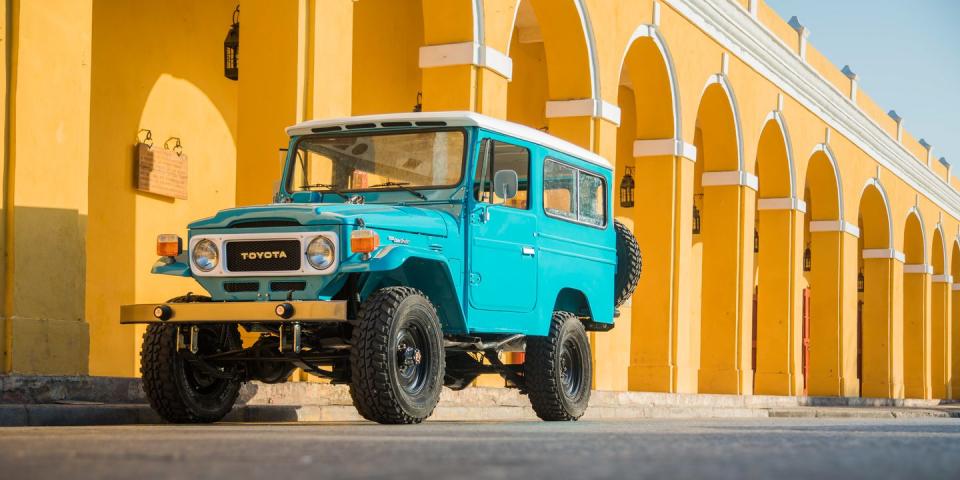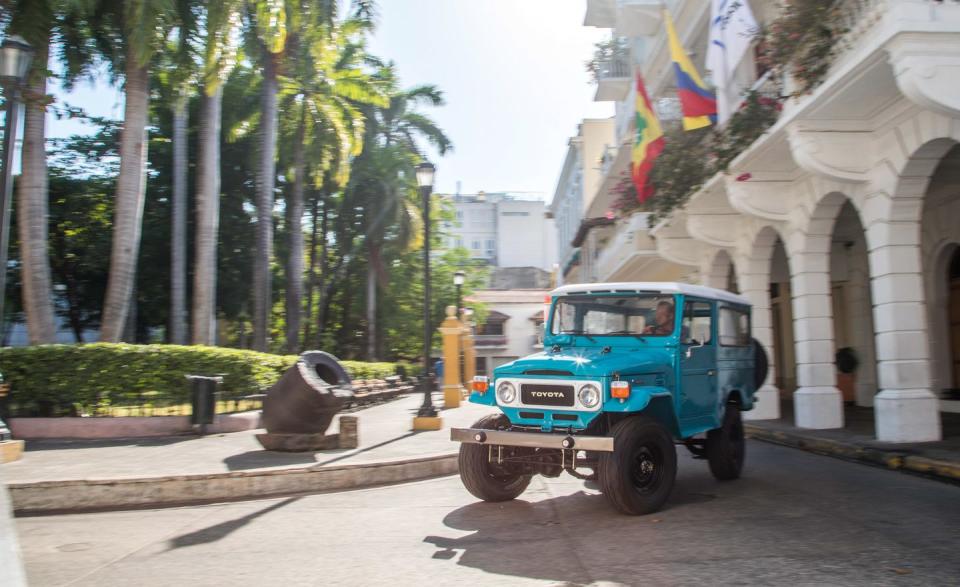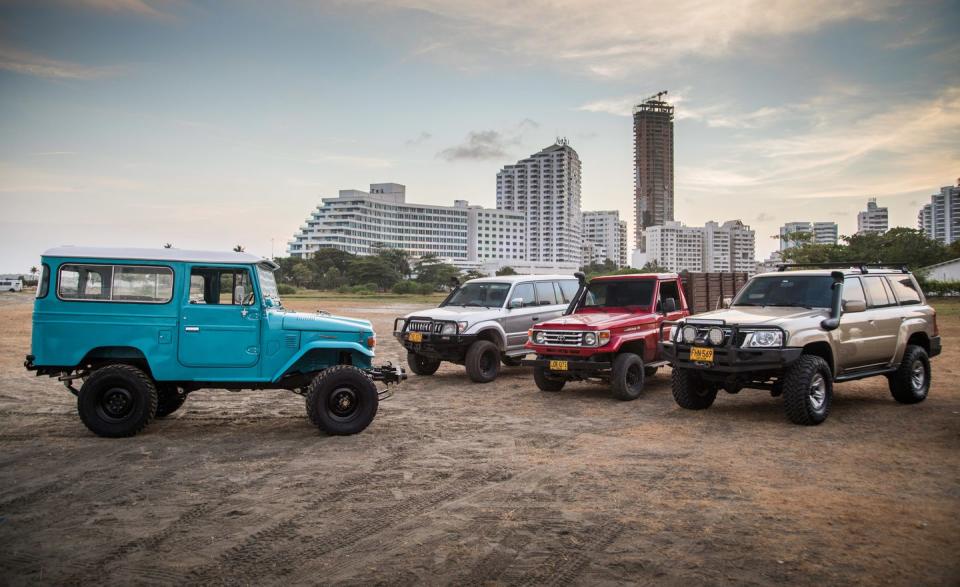How to Import Vintage Toyota FJ40 Land Cruisers from South America

In contrast to the suburban comfortmobile that is the modern Toyota Land Cruiser, the early version is a work truck if ever there was one. Rugged and reliable, they could be driven-and repaired-in the most remote places on Earth. Toyota sold them in great numbers worldwide since introducing the original in 1951. By volume, the FJ40 series-produced from 1960 to 1984 with few changes-was the most popular. On most continents, it could be had with either a gasoline or diesel engine and in three lengths, dubbed FJ40, FJ43, or FJ45, not all of which made it to the United States as official imports. The Land Cruiser was, in the early 1960s, the best-selling Toyota in America, before the car line really got going and regulators had much to say about safety and emissions. Fewer than 10,000 (sometimes a lot fewer) were sold here each year from 1974 through the last few hundred 1983 models (Canada saw a few of the last-model-year 1984 FJ40s).
So, our native supply is limited in both number and variety. But, since they’re more than 25 years old, you can bring an FJ40/43/45 into the U.S. from anywhere. First, understand, they’re not exactly suited for your daily commute. From the factory, they peaked at 135 horsepower from the 4.2-liter inline-six, mated to a four-speed manual transmission. Things get pretty hairy at highway speeds. You won’t find one with factory air, and most don’t even have heat. Still, it’s the cool factor that makes adding an old FJ to your collection a worthwhile consideration-despite the fact that its prices have risen. A lot.
Maybe you’ve read up on some of the high-end restorers but don’t like the thought of dropping $120,000 to $200,000 on an old Land Cruiser. There’s every reason to think that flying to one of the overseas markets and shipping yourself a truck is the better idea; it wasn’t long ago that a good FJ40 could be had for $3000 to $4000. That’s no longer the case, though-foreign markets are very aware of demand worldwide, which has caused prices to soar to double or more what they were a few years ago. That money doesn’t buy a restored truck, either, although they’re often advertised as such.
There has been a flurry of companies cropping up in recent years to take advantage of the no-holds-barred 25-year importation rule, promising to deliver exactly the vintage Land Cruiser you need, with clean title in hand. They’ll source a Land Cruiser from Australia, Africa, Japan, or anywhere else in the world, but the “restored” vehicles tend to come from South America, and the smart money is probably on having your car restored while it’s still overseas. Even if the truck was fastidiously maintained in, say, Germany, it’s still a 40-year-old vehicle.
Frank Diaz owns Land Cruiser Heaven, an importer in Hagerstown, Maryland, that brings in trucks from Colombia. “The number one reason you want a middleman to source the truck-restored or not-is time,” Diaz says. “This isn’t the sort of thing you’re going to do over a weekend in Cartagena.” He’s right: these aren’t new trucks or even newish ones. And what’s more, they’re work-duty trucks in South America, not luxury go-getters from Beverly Hills. Often used as colectivos, or short-hop public transportation, they’re loaded to the brim with people and stuff, driven until the wheels fall off, then rebuilt. The old nine-lives cliché doesn’t begin to describe the tenure of an FJ in South America. “You’ll need to look at quite a few before you find a suitable candidate,” Diaz says.
Even if you’ve located a prime example, there is no Importing from Colombia for Dummies handbook. For all of the reasons you’ve seen on Netflix, neither exporting from Colombia nor importing on the U.S. side is a piece of cake. Diaz enlightens us:
You can only export if you’re the owner. Except you can’t be the owner unless you’ve got Colombian paperwork. You don’t have to be a citizen, but you need a couple of weeks on the ground to get the proper papers filed and come out with a Cédula de Extranjería, essentially a foreigner’s ID card.
The authorities will want to make sure you’ve jumped through all the requisite legal hoops and that all the previous owners have done so, too, which is something outside your control. That means back taxes and police inspections. They’ll check to be sure the engine matches the frame, probing for inconsistencies and forgeries. Each time the truck is sold, imprints are made of both the engine number and the frame number. Forgeries are common (the engine number has been bluffed to match the chassis), and that will mean the truck will be impounded until you can prove its legality. The cops will check to be sure the paint color is the same as what they have on its paperwork. Is it a hardtop? Softtop? It all has to match, and after 40 years in South America, it very likely doesn’t.
Then there’s exporting. If you’re not connected, paperwork is inconsistent and time-consuming. But that’s not the big issue. Do you trust the seller? Do you know where the truck has been each minute since you paid for it? Read: There are people whose job it is to pay you a visit when your truck arrives stateside, laden with cocaine. If you get that far, anyway. Before you export, you sign your life away with the Antinarcoticosdivision. If the Colombians find drugs-and they aren’t exactly amateurs-guess who’s getting locked up abroad?
Then there’s importing. It should not be surprising to hear at this point that it’s tough to find a shipper that will gleefully take your 4000-pound rig out of Colombia and ship it to the United States. Often, additional background checks are required. Many shippers are just unwilling to risk the liability.
Then there’s the DMV. It’s enough of a hassle to title an ordinary car sold new in the United States. What do you think the process looks like for a truck that was not originally sold here, with an ID card for a title that can’t be signed over? How about those customs papers? Customs does everything electronically, but your local DMV probably wants physical paperwork, complete with a Homeland Security stamp. Diaz says he was once asked to go to the Colombian consulate to have a vehicle title validated. As with your experience in getting the truck out of one country, getting it in here all depends on whom you’re interfacing with. Your headaches will differ by state, but, Diaz ensures us, you will have them.
So, it helps to have a middleman. In many cases, these trucks are being imported from regions that are ill equipped for proper restoration work. The outfits that put the money into education and proper facilities are probably worth the extra coin. The definition of “restored” varies greatly in the unpaved world; most restorations won’t include an engine rebuild, for instance. You’ll want to delineate exactly what’s to be done, and while you’re spec’ing your build, be sure to specify exactly the parts you want (OE Toyota, for instance). You need to watch progress like a hawk, too; if there’s a shortcut to be taken, many of these restorers will take it and make excuses when it’s too late for an easy fix.
As with anything else, there are varying grades of workmanship, usually with a linear correlation to price. Deals that seem too good to be true are . . . well, you know the rest. Land Cruiser and expedition forums such as ih8mud.com are good resources to tap when attempting to determine the reputation of restorers. Beware, though: Even if you get a highly rated importer, there are obstacles. Watch for a story to appear here soon detailing exactly what happened to one buyer.
('You Might Also Like',)

 Yahoo Autos
Yahoo Autos 

